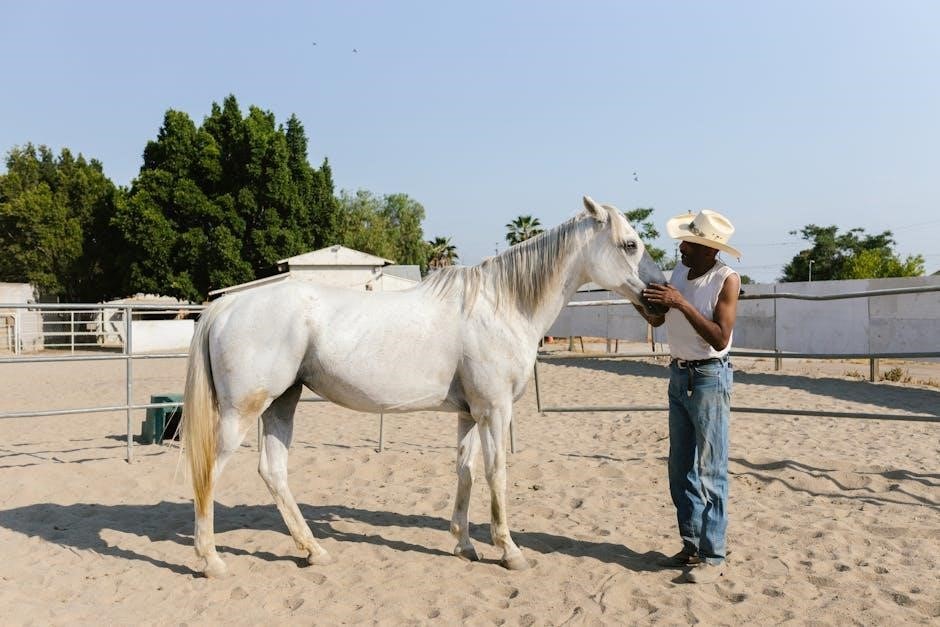Diaper discipline is a routine that promotes healthy development through consistent changes and hygiene‚ ensuring your baby’s comfort and preventing issues like diaper rash. Key aspects include understanding signs of needing a change and maintaining proper hygiene‚ which are crucial for your child’s well-being and long-term health.
By establishing a structured approach‚ you can create a supportive environment that fosters trust and security‚ laying the foundation for successful potty training and overall developmental milestones.
What is Diaper Discipline?
Diaper discipline refers to a structured approach to managing a baby’s diaper needs through consistent routines and awareness. It involves recognizing signs of a soiled diaper‚ such as fussiness or physical discomfort‚ and responding promptly to ensure cleanliness and comfort. This practice emphasizes the importance of hygiene and creates a predictable environment for the child. By using tools like schedules or observation‚ parents can anticipate and address their baby’s needs effectively‚ fostering trust and security. Diaper discipline also incorporates positive reinforcement‚ such as praise‚ to encourage cooperation and readiness for future potty training‚ laying a strong foundation for healthy development.
Why Diaper Discipline is Important
Diaper discipline is crucial for maintaining a baby’s health and comfort by preventing prolonged exposure to soiled diapers‚ which can lead to skin irritation and infections. It helps parents recognize their child’s needs‚ fostering a sense of security and trust. Consistent routines also lay the groundwork for potty training‚ making the transition smoother. Additionally‚ diaper discipline encourages parents to stay vigilant about hygiene‚ reducing the risk of diaper rash and promoting overall well-being. By prioritizing these practices‚ parents contribute to their child’s physical and emotional development‚ ensuring a healthy and happy start in life. Early habits set the stage for future independence and confidence.

Understanding Diaper Discipline
Diaper discipline involves creating a structured routine to ensure consistent diaper changes‚ promoting hygiene‚ and preventing accidents. It fosters a healthy environment for your baby’s development and comfort.
Signs Your Baby Needs Diaper Discipline
Your baby may need diaper discipline if they experience frequent accidents‚ show signs of discomfort‚ or develop skin irritation. Diaper rash‚ restlessness‚ and delayed communication of needs are key indicators. Consistent changes and proper hygiene can prevent these issues‚ ensuring your baby’s comfort and health. By recognizing these signs early‚ you can establish a routine that promotes healthy development and reduces the risk of complications. Diaper discipline helps create a structured approach to caregiving‚ fostering trust and security for your child.
How Diaper Discipline Promotes Healthy Development
Diaper discipline plays a crucial role in fostering trust and security in your baby‚ laying the groundwork for healthy development. By establishing consistent routines‚ you help your child learn self-regulation and communication skills. A structured approach to diaper changes reduces discomfort and prevents issues like diaper rash‚ creating a safe environment for growth. This routine also encourages independence and readiness for potty training‚ while reinforcing motor skills and problem-solving abilities. Over time‚ diaper discipline contributes to emotional stability and confidence‚ setting a strong foundation for your child’s overall development and well-being.

Choosing the Right Diapers
Selecting the right diapers involves considering factors like absorbency‚ comfort‚ and skin sensitivity. Cloth and disposable options offer unique benefits‚ with cloth being eco-friendly and reusable‚ while disposables prioritize convenience and hygiene‚ reducing the risk of leaks and rashes. Understanding your baby’s needs and lifestyle helps make an informed decision‚ ensuring optimal comfort and health for your child.
Cloth vs. Disposable Diapers: Pros and Cons
Cloth diapers are eco-friendly and cost-effective in the long run‚ but require regular washing and maintenance. Disposable diapers offer unmatched convenience and hygiene‚ reducing the risk of leaks and rashes‚ but are more expensive and contribute to environmental waste. Cloth diapers promote healthier skin due to natural materials‚ while disposables are lightweight and ideal for active lifestyles. Ultimately‚ the choice depends on your priorities—whether you value sustainability‚ convenience‚ or budget efficiency. Both options have their drawbacks‚ but selecting the right one can enhance your diaper discipline routine and your baby’s comfort.
Key Features to Look for in Diapers
When selecting diapers‚ prioritize absorbency to prevent leaks and skin irritation. Look for multiple layers of absorbent material and a snug‚ adjustable waistband for a secure fit. Breathable materials help prevent diaper rash‚ while moisture-wicking liners keep your baby dry. For cloth diapers‚ consider reusable designs with removable inserts for convenience. Disposable diapers should have leak-proof leg cuffs and wetness indicators for easy monitoring. Eco-friendly options are ideal for environmentally conscious parents. Ensure the diapers are free from harsh chemicals and hypoallergenic to protect sensitive skin. Proper fit and comfort are essential for effective diaper discipline and your baby’s overall well-being.

Creating a Diaper Changing Routine
Establishing a consistent schedule ensures timely changes‚ preventing accidents and discomfort. Prepare all necessary supplies in advance to maintain efficiency and promote a calm environment for your baby.
How to Establish a Diaper Changing Schedule
Start by observing your baby’s patterns to determine frequency needs. Newborns may require changes every 2-3 hours‚ while older babies can go 3-4 hours. Keep a log to track changes‚ noting wet or soiled diapers‚ to identify routines and anticipate needs. Prepare all supplies in advance to ensure efficiency and reduce stress. Look for signs of discomfort or specific behaviors that indicate a need for a change. Be flexible‚ as schedules may vary daily‚ and adjust accordingly to maintain effectiveness and comfort for your baby.
Preparing the Necessary Supplies
To ensure effective diaper changes‚ gather essential items like diapers‚ wipes‚ and a changing pad. Keep a diaper caddy stocked with extra supplies for convenience. Use a trash can with a lid for soiled diapers to maintain hygiene. Include hand sanitizer‚ diaper cream‚ and burp cloths in your kit. Organize storage spaces to keep everything accessible. Consider a portable changing mat for on-the-go needs. Optional items like a wipes warmer or diaper genie can enhance efficiency. Always restock supplies regularly to avoid shortages. A well-prepared setup ensures smooth and stress-free diaper changes‚ promoting a clean and comfortable environment for your baby.

Positive Reinforcement Techniques
Positive reinforcement involves using praise and rewards to encourage desired behaviors. Praise your baby after successful changes‚ and consider small rewards for consistency. This fosters a supportive environment and motivates your child to embrace the routine‚ creating a positive association with diaper discipline.
The Role of Praise and Affirmation
Praise and affirmation play a vital role in diaper discipline by encouraging positive behavior and fostering a sense of accomplishment. Verbal encouragement‚ such as saying “Great job!” after a successful change‚ helps build your baby’s confidence and reinforces the routine.
Physical gestures like hugs or high-fives can also strengthen the bond between you and your child. This positive reinforcement creates a supportive environment‚ making your baby more receptive to the process and reducing the likelihood of resistance or accidents over time.
Using Reward Systems Effectively
Reward systems are a powerful tool in diaper discipline‚ motivating your child to cooperate during changes. Simple rewards like stickers‚ small toys‚ or special privileges can create a positive association with the process.
Consistency is key—offer rewards immediately after successful changes to reinforce good behavior. Over time‚ this encourages self-initiative and reduces resistance. As your child grows‚ adapt the rewards to their interests‚ ensuring the system remains engaging and effective in fostering a smooth transition to independence.

Handling Accidents and Setbacks
Accidents are inevitable‚ but staying calm and learning from setbacks helps refine your approach. Identify triggers and adjust strategies to minimize future occurrences.
How to Stay Calm During Diaper Accidents
Diaper accidents can be stressful‚ but staying calm is essential for effective management. Take deep breaths and remind yourself that accidents are part of the learning process. Positive affirmation helps maintain a composed mindset. Clean up methodically‚ focusing on your baby’s comfort and hygiene. Soothing communication reassures your child‚ fostering trust. Consistency is key; avoid punitive reactions‚ as they may cause anxiety. Instead‚ use these moments to identify triggers and refine your approach. By staying calm‚ you create a supportive environment for both you and your baby to grow and adapt.
Identifying Common Triggers for Accidents
Understanding triggers for diaper accidents is crucial for minimizing their occurrence. Common causes include irregular feeding schedules‚ excessive liquid intake‚ or physical activity that increases pressure on the diaper. Overlooking subtle signals‚ such as squirming or vocal cues‚ can also lead to accidents. Inconsistent diaper changes or improper sizing may exacerbate the issue. Additionally‚ distractions during changes or not fully securing the diaper can contribute. By observing patterns and addressing these factors‚ you can tailor your approach to reduce accidents and promote a smoother routine for both you and your baby.

Monitoring Progress and Adjusting Your Approach
Regularly track diaper changes and patterns to identify trends and areas for improvement. Adjusting your strategy based on your baby’s unique needs ensures long-term success and comfort.
Tracking Diaper Changes and Patterns
Consistently documenting diaper changes helps identify patterns and trends‚ ensuring your baby’s needs are met. Note the time of each change‚ whether it’s wet or soiled‚ and any inconsistencies. This data is crucial for anticipating your baby’s requirements and preventing accidents. By monitoring these patterns‚ you can adjust your approach to better suit your baby’s unique rhythm and developmental stage. Over time‚ this practice supports a smoother transition to potty training and reinforces the principles of diaper discipline‚ fostering a healthier and more comfortable environment for your child to thrive.
Knowing When to Seek Professional Help
If your baby experiences persistent diaper rash‚ skin irritation‚ or shows signs of distress during changes‚ consult a pediatrician. Professionals can offer tailored advice and address underlying issues. Additionally‚ if you notice significant delays in development or resistance to potty training‚ seeking expert guidance is advisable. Health organizations emphasize the importance of early intervention for optimal outcomes. By monitoring your baby’s progress and responding to concerns promptly‚ you ensure their well-being and set the stage for successful growth and development. Remember‚ professional support is a valuable resource in your diaper discipline journey.

Common Mistakes to Avoid
Avoid inconsistent diaper changes‚ as it leads to discomfort and setbacks. Neglecting hygiene can cause rashes. Stay vigilant to prevent these errors‚ ensuring your baby’s well-being. Always prioritize cleanliness and consistency in your routine to support healthy development and comfort. Be mindful of these pitfalls to create a positive experience for your child.
Overlooking the Importance of Hygiene
Proper hygiene is essential for preventing diaper rashes and infections. Neglecting to clean thoroughly during changes can lead to discomfort and health issues. Always use gentle‚ fragrance-free wipes and ensure the diaper area is dry before securing a new diaper. Skipping steps like handwashing or rinsing reusable diapers can reintroduce bacteria‚ causing irritation. Consistent hygiene practices not only protect your baby’s skin but also contribute to a healthier environment for development. Prioritize cleanliness to avoid setbacks and ensure your baby’s comfort and well-being at every stage.
The Dangers of Inconsistent Diaper Discipline
Inconsistent diaper discipline can lead to confusion for your baby‚ delaying potty training progress and causing frustration for both parent and child. Irregular schedules may result in more accidents‚ skin irritation‚ and discomfort. Over time‚ this inconsistency can erode trust and create resistance to the process. It’s crucial to maintain a structured routine‚ ensuring your baby associates diaper changes with cleanliness and care. Without consistency‚ you risk undoing the progress made‚ making the journey to independence more challenging. A reliable approach fosters security and cooperation‚ while inconsistency undermines these efforts‚ leading to setbacks and prolonged dependency.

Health Considerations
Diaper discipline plays a crucial role in maintaining your baby’s skin health‚ preventing infections‚ and ensuring overall comfort through consistent‚ hygienic practices.
Preventing Diaper Rash
Preventing diaper rash requires consistent diaper changes‚ proper cleaning‚ and keeping the area dry. Using barrier creams can protect sensitive skin from irritation. Ensure diapers fit properly to avoid friction and moisture buildup. Regularly checking for early signs of redness or irritation is crucial. A clean‚ breathable environment helps prevent bacterial growth. Avoiding irritants like fragrances in wipes or creams can reduce risk. Maintaining good hygiene during changes and allowing skin to air out occasionally are key. By following these steps‚ you can reduce the likelihood of diaper rash and promote healthy skin for your baby.
Maintaining Proper Hygiene
Maintaining Proper Hygiene
Maintaining proper hygiene during diaper changes is essential for your baby’s health and comfort. Always wash your hands before and after handling the diaper. Use clean wipes to gently cleanse the area‚ ensuring to remove all residue. Dispose of soiled diapers in a designated bin to prevent odor and germ spread. Regularly sanitize changing surfaces and utensils to minimize bacterial growth. Proper hygiene practices help prevent infections and skin irritations‚ creating a safe environment for your baby to thrive. Consistency in these habits is vital for effective diaper discipline and overall wellness.

Parental Consistency and Support
Consistency and teamwork between parents are vital for effective diaper discipline. Both caregivers must align on routines and expectations to create a stable‚ supportive environment for the baby.
Ensuring Both Parents Are on the Same Page
Consistency between parents is crucial for effective diaper discipline. Open communication and mutual respect ensure both caregivers align on routines‚ expectations‚ and approaches. Discussing preferences and concerns prevents conflicts‚ fostering a united front. Sharing responsibilities and establishing a shared routine creates stability for the baby. When both parents are committed‚ it reinforces the baby’s sense of security and trust. Regular check-ins help maintain alignment‚ ensuring the approach remains consistent and supportive. This teamwork not only benefits the baby’s well-being but also strengthens the parental bond‚ creating a harmonious environment for healthy development.
Building a Supportive Environment
Creating a supportive environment for diaper discipline involves fostering a calm and loving atmosphere. Consistency and patience are key‚ as they help the baby feel secure. Open communication between parents ensures alignment in approaches‚ preventing confusion. Positive reinforcement‚ such as praise‚ encourages cooperation and builds trust. A clean‚ safe space for diaper changes minimizes stress and promotes hygiene. By addressing the baby’s physical and emotional needs‚ you create a nurturing setting that supports healthy development and strengthens the bond between parent and child.
Key Takeaways
- Consistency and communication are cornerstones of effective diaper discipline‚ fostering trust and security for your baby.
- Regular diaper changes prevent discomfort and health issues like diaper rash‚ ensuring your child’s well-being.
- Positive reinforcement‚ such as praise‚ encourages cooperation and builds confidence during the process.
- Tracking patterns and adapting strategies helps address setbacks and promotes long-term success.
- Creating a supportive environment with clear routines lays a strong foundation for healthy development.
These strategies collectively contribute to a positive and nurturing experience for both parents and baby.
Final Thoughts
Diaper discipline is a journey that requires patience‚ consistency‚ and understanding. By fostering a supportive environment and maintaining open communication‚ you can help your child feel secure and confident. Remember‚ every child is unique‚ and adapting strategies to their needs is key. Tracking progress and staying flexible ensures long-term success. Celebrate small milestones‚ as they pave the way for significant developmental achievements. With dedication and love‚ diaper discipline becomes more than a routine—it’s a foundation for healthy growth and a strong parent-child bond. Stay committed and cherish the journey of nurturing your child’s well-being.



